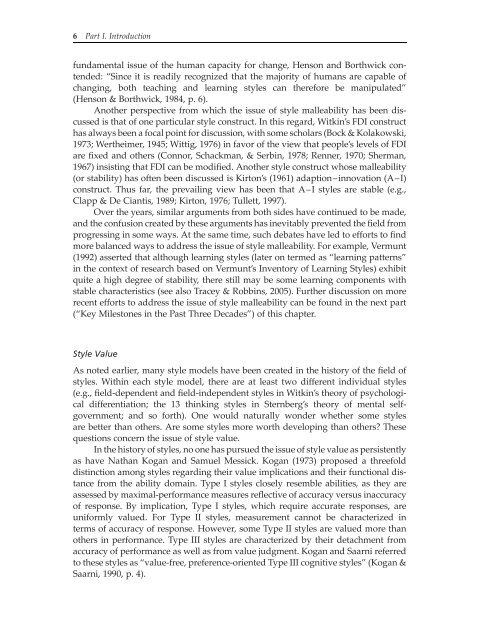Handbook of Intellectual Styles - Springer Publishing
Handbook of Intellectual Styles - Springer Publishing
Handbook of Intellectual Styles - Springer Publishing
Create successful ePaper yourself
Turn your PDF publications into a flip-book with our unique Google optimized e-Paper software.
6 Part I. Introduction<br />
fundamental issue <strong>of</strong> the human capacity for change, Henson and Borthwick contended:<br />
“Since it is readily recognized that the majority <strong>of</strong> humans are capable <strong>of</strong><br />
changing, both teaching and learning styles can therefore be manipulated”<br />
(Henson & Borthwick, 1984, p. 6).<br />
Another perspective from which the issue <strong>of</strong> style malleability has been discussed<br />
is that <strong>of</strong> one particular style construct. In this regard, Witkin’s FDI construct<br />
has always been a focal point for discussion, with some scholars (Bock & Kolakowski,<br />
1973; Wertheimer, 1945; Wittig, 1976) in favor <strong>of</strong> the view that people’s levels <strong>of</strong> FDI<br />
are fixed and others (Connor, Schackman, & Serbin, 1978; Renner, 1970; Sherman,<br />
1967) insisting that FDI can be modified. Another style construct whose malleability<br />
(or stability) has <strong>of</strong>ten been discussed is Kirton’s (1961) adaption–innovation (A–I)<br />
construct. Thus far, the prevailing view has been that A–I styles are stable (e.g.,<br />
Clapp & De Ciantis, 1989; Kirton, 1976; Tullett, 1997).<br />
Over the years, similar arguments from both sides have continued to be made,<br />
and the confusion created by these arguments has inevitably prevented the field from<br />
progressing in some ways. At the same time, such debates have led to efforts to find<br />
more balanced ways to address the issue <strong>of</strong> style malleability. For example, Vermunt<br />
(1992) asserted that although learning styles (later on termed as “learning patterns”<br />
in the context <strong>of</strong> research based on Vermunt’s Inventory <strong>of</strong> Learning <strong>Styles</strong>) exhibit<br />
quite a high degree <strong>of</strong> stability, there still may be some learning components with<br />
stable characteristics (see also Tracey & Robbins, 2005). Further discussion on more<br />
recent efforts to address the issue <strong>of</strong> style malleability can be found in the next part<br />
(“Key Milestones in the Past Three Decades”) <strong>of</strong> this chapter.<br />
Style Value<br />
As noted earlier, many style models have been created in the history <strong>of</strong> the field <strong>of</strong><br />
styles. Within each style model, there are at least two different individual styles<br />
(e.g., field-dependent and field-independent styles in Witkin’s theory <strong>of</strong> psychological<br />
differentiation; the 13 thinking styles in Sternberg’s theory <strong>of</strong> mental selfgovernment;<br />
and so forth). One would naturally wonder whether some styles<br />
are better than others. Are some styles more worth developing than others? These<br />
questions concern the issue <strong>of</strong> style value.<br />
In the history <strong>of</strong> styles, no one has pursued the issue <strong>of</strong> style value as persistently<br />
as have Nathan Kogan and Samuel Messick. Kogan (1973) proposed a threefold<br />
distinction among styles regarding their value implications and their functional distance<br />
from the ability domain. Type I styles closely resemble abilities, as they are<br />
assessed by maximal-performance measures reflective <strong>of</strong> accuracy versus inaccuracy<br />
<strong>of</strong> response. By implication, Type I styles, which require accurate responses, are<br />
uniformly valued. For Type II styles, measurement cannot be characterized in<br />
terms <strong>of</strong> accuracy <strong>of</strong> response. However, some Type II styles are valued more than<br />
others in performance. Type III styles are characterized by their detachment from<br />
accuracy <strong>of</strong> performance as well as from value judgment. Kogan and Saarni referred<br />
to these styles as “value-free, preference-oriented Type III cognitive styles” (Kogan &<br />
Saarni, 1990, p. 4).

















